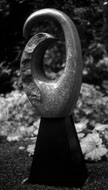As is true for many of our members, “late bloomer” may be applied to Pasha Stinson. Following one career, he applied his energies to sculpture in a very conscientious fashion. His training began with one of our members and has extended to the international realm. The result has been a steady production of beautiful pieces.
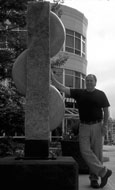
LE: Who are you?
PS: Growing up in southern Oregon as the oldest of seven children in a blue-collar family where practical skills were valued necessities, a career in civil engineering was a logical choice. I put myself through Oregon State University by holding down jobs in logging and construction in Oregon, California and Alaska.
LE: Where did your interest in sculpture originate?
PS: My school schedule did not have the flexibility to allow any art courses in college. Decades of being employed in the construction industry gave me plenty of experience with a myriad of tools, but I was only free to create the designs of others. The little free time I had was often spent creating sculpture in wood and steel for myself or friends and family.

LE: Then none of your early work was in stone?
PS: No. I had reached my mid-fifties and made a decision to allow myself to pursue some of my other interests in life. I moved from Hawaii, where I was working, back to the Northwest. I wanted to find something where I could use the skills I had in a more creative way. As a birthday present, my wife gave me a stone carving class, taught by Brian Berman. I discovered an immediate affinity and passion for this medium and rapidly came to the realization that I wanted to devote full-time to developing and evolving my artistic ability.
LE: How did you learn about NWSSA?
PS: Brian spoke very enthusiastically of the artists who were members of the association, his experiences at Camp Brotherhood, and showed me copies of the newsletter. This was enough to convince me that I wanted to become a member.
LE: How does your experience as an engineer relate to your artistic style?
PS: Most of my life I have found it much more comfortable to think in forms or shapes as opposed to thinking in words or concepts. As my own style of sculpture has developed, I would say that shape or form is primary in importance, with contrasting texture being a major feature. My sculptures are abstract but often suggest sweeping, sensuous forms found in nature. Engineering left me with no desire to sculpt square, linear forms.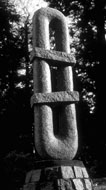
LE: What stones do you prefer in your work?
PS: Geology and a love of natural stone attracted me to stone sculpture in the first place and I find I prefer to carve both beautiful and exotic materials, with a distinct preference toward the harder stones, granite, basalt and the harder marbles. I love to incorporate interesting natural features of the raw stone into my works. This often takes more effort, but the results can be stunning.
LE: It sounds like your learning curve for stone sculpture has been intense and fairly concentrated. What have been the significant influences aiding your development?
PS: I have learned a great deal from my contact with members of NWSSA as well as my original classes with Brian Berman. Well-known sculptors that have influenced my work are Isamu Noguchi and Jesus Morales. Even though I work in an abstract style, I greatly admire artists who incorporate realistic style into their work. Two artists that come to mind in the association are Alex Morosco and Sabah Al-Dhaher. I want to develop my ability in that area, in the future. I have also found all of the symposiums I have attended to be extremely helpful in developing my own artistic style and expanding my carving skills. Over a four-year period, I have been lucky enough to participate in Camp Brotherhood, Marble/Marble, a short symposium in New Mexico on carving granite, and two symposiums in The Netherlands: De Stenen Port and Recontres Sculptural.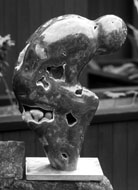
LE: Where do you exhibit your work?
PS: I am very happy to have a number of pieces at the Lawrence Gallery in Portland. This gallery is located in the Pearl district which has positioned itself as a factor in the Northwest art scene. The Lawrence has just constructed a new outdoor garden next to the gallery, capable of showing larger sculptures. Two of my larger works, ‘Scheherazade’ and ‘The Offering’ are displayed there. I also have some smaller pieces in the Mark Bergsma gallery, located on Bellingham Bay. ‘In Balance’, a piece in Belgian black marble, carved this summer at a symposium in The Netherlands, is showing at a gallery in Maastricht.
LE: Have you found other venues for showing your work?
PS: The Northwest is fortunate to have a number of art shows held in many local communities. I have taken part in several of these shows, but as the size and weight of the sculptures I enjoy creating have grown, I find that it is not as easy to use this venue to display the larger works.
A growing trend in the US art world has been the increasing number of sculpture parks and urban displays featuring works loaned by artists. Since I like to work big and in durable stone, these opportunities are a natural fit for me. I get to create what I want and the public gets to enjoy a little more art.
LE: What is your studio like?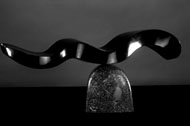
PS: When Cathy and I settled on Bainbridge Island, we constructed a shop on our property. It was a great building but not well suited to stone carving. We then poured a concrete work slab that we have plumbed for electric, air and water, next to the studio. As it turns out, I am lucky in my choice of houses in not having any close neighbors.
LE: Have you had to do anything special to facilitate working on larger pieces?
PS: During this last year, I fabricated a gantry crane to handle works in my outdoor carving area. I installed a hand powered chain hoist with a 3 ton lifting capacity. Using manual instead of electrical power keeps the cost and maintenance low. I put a clear roof over the entire structure to allow me to work outside through the winter months.
LE: What tools do you use in your work?
PS: I had the advantage in having worked previously with many of the tools’ we use in carving. I enjoy using hand tools, but since I work large, hard stone, I find that most of my work is accomplished with power tools. Diamond blades on angle grinders and pneumatic carving tools with carbide chisels, are the mainstay of my work. If I am polishing, I am often using power tools with water injection and diamond-plastic pads, but I have found interesting textures in sandblasting or flaming the finished surface. Drilling and splitting with feather wedges as well as coring, all have their uses. Yes, I would say I enjoy tools!
LE: Do you have a piece you find particularly interesting?
PS: I seem to always be the most excited by the piece I am working on or just finished. Generally, I work on just one sculpture at a time. A recent one that I finished is a good example. I brought in about 12 tons of granite from India, both black and gold stone that took about five months to get here. I was busy fabricating my gantry when it arrived, so evenings I did drawings and some models for a couple of the raw, split stones. I timed the start of one of my ideas with a trip my wife was taking to Portland to baby-sit our three year old grandson. I was working with 4700 pounds of golden granite. When Cathy returned a week and a half later, ‘Temptation’ was done. This method is not always the best on your body, but it seems to be productive for me and is a trait that is required by many symposiums. The sculpture is still 3000 pounds and over 8 feet tall, but I was able to complete it by working around the clock. This sculpture has been installed in downtown Everett in their first municipal sculpture exhibit. (ed.: see Nov/Dec ’03 issue)
LE: Then do you sculpt full time?
PS: Yes, but as I described, my method of working divides my time into very intense blocks of sculpting, with family, travel, and chores filling the time between.
LE: How do develop your ideas?
PS: I find myself direct carving smaller stone sculptures but generally both drawing and modeling the larger works. I don’t feel compelled to follow the model exactly, but creating the model beforehand gives me a clearer three-dimensional view before attacking the larger work.
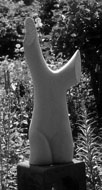
LE: How much work do you produce in a year?
PS: I like to create three to four large pieces each year and try to complete six to seven gallery-sized pieces. An additional goal I have set for myself is to participate in at least one if not two national or international symposiums a year to broaden my contact with other artists and to improve my skills.
LE: What do you envision for the future?
PS: I really don’t know what direction that being a sculptor will take me in the future. All I know is that this was not something that I really planned on but it has become key in my life and I can’t imagine not going out and carving another idea. I have enjoyed the work, the people that it has brought me in contact with and the places I have traveled because of carving. I just hope that I have a number of years of productive career ahead. 